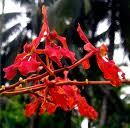Fire Orchid, comes from the genus of Renanthera, is a beautiful plant and as it connotes, it has intensely red flowers.
It is currently used as a parent plant in breeding bright red conventional and inter-generic vandaceous orchid hybrids.
It is also used as an accent in garden shows and flower arrangements. Some of these plants can grow very tall so they require stakes to support their long stems.
The matured Fire Orchid grows in moderate hot sun, and needs to be protected from intense heat especially at noon time to prevent leaf scorching. There is need for regular watering of this plant during summer.
Fire Orchids can be planted in soil enriched with animal manure and mulched with wood shavings or coconut husks. Some growers plant them in 12-inch diameter clay pots with gravel plus charcoal or in wood slat baskets as their propagating materials.
Plants are often staked with bamboo or thick wire to make the stem upright. For epiphytic types, they can be mounted on wood branches, trunks or drift wood.
To fertilize, spray dilute orchid foliar fertilizers with trace elements once a week, usually after watering them in the morning. Protect plants from weevils and sucking insects like mites and aphids by spraying environmentally friendly insecticides that can be available in the market.
Allow proper spacing and ventilation between plants to facilitate air movements to keep them properly ventilated and prevent them from spoiling.
Generally, Renanthera has 15 known species available containing numerous flowers and variance shade of colors ranging from red, yellow and orange.
In the Philippines there are four species of Renanthera found. Three of them are endemic, namely the Renanthera monacheca, Renanthera philippinensis and Remanthera storiei.
The other one is the Renanthera matutina which is indigenous. The Renantheras are closely related to the Vanda and Arachnis family of orchids.
These plants are usually epiphytes. Occasionally, some plants start their life as a soil growing orchid, and its stem gradually climbs up the trunk of a tree and becomes an epiphyte.
